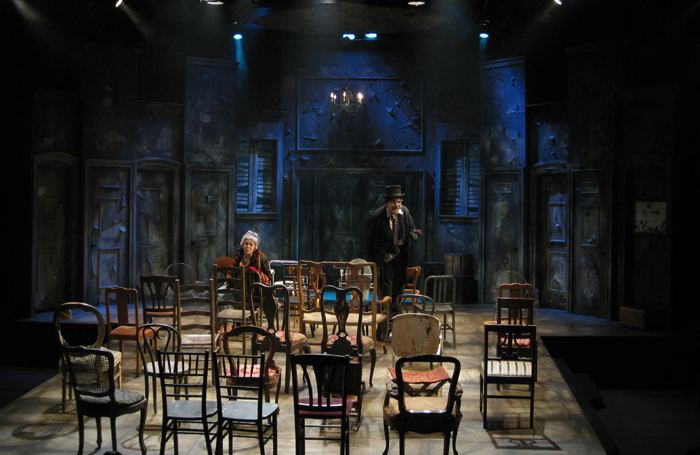First performance 22 April 1952 | ||
 | ||
Similar Eugène Ionesco plays, Tragedies, Other plays | ||
The chairs by eug ne ionesco
The Chairs (French: Les Chaises) is an absurdist "tragic farce" play by Eugène Ionesco. It was written in 1952 and debuted the same year.
Contents
The chairs
Plot
The play concerns two characters, known as Old Man and Old Woman, frantically preparing chairs for a series of invisible guests who are coming to hear an orator reveal the Old Man's discovery. It is implied that this discovery is the meaning of life, but it is never actually said. The guests supposedly include "everyone", implying everyone in the world; there are other implications that this is a post-apocalyptic world. The Old Man, for example, speaks of the destruction of Paris. The invisibility of the guests implies that the Old Man and Old Woman are the last two people on the planet. As the "guests" arrive, the two characters speak to them and reminisce cryptically about their lives. A high point in the happiness of the couple is reached when the invisible emperor arrives. Finally, the orator arrives to deliver his speech to the assembled crowd. Played by a real actor, the orator's physical presence contradicts the expectations set up by the action earlier in the play.
The old couple then commit suicide by throwing themselves out of the window into the ocean. They claim that life couldn't get any better at this point because the whole world is about to hear the Old Man's astounding revelation. As the orator begins to speak, the invisible crowd assembled in the room and the real audience in the theatre discover that the orator is a deaf-mute.
At the end of the play, the sound of an audience fades in. Ionesco claimed that this sound was the most significant moment in the play, writing in a letter to the first director, “The last decisive moment of the play should be the expression of ... absence,” He said that after the Orator leaves, "At this moment the audience would have in front of them ... empty chairs on an empty stage decorated with streamers, littered with useless confetti, which would give an impression of sadness, emptiness and disenchantment such as one finds in a ballroom after a dance; and it would be after this that the chairs, the scenery, the void, would inexplicably come to life (that is the effect, an effect beyond reason, true in its improbability, that we are looking for and that we must obtain), upsetting logic and raising fresh doubts."
Productions
The play was first produced on 22 April 1952 at the Théâtre Lancry under the direction of Sylvain Dhomme. It was revived in 1956 at the Studio des Champs Elysées, directed by Jacques Mauclair. Two revivals of the play were produced in 1997 and 1998. One developed as a collaboration between Theatre de Complicite and the Royal Court Theatre, was directed by Simon McBurney, and became a surprise hit in London, later running at the John Golden Theatre on Broadway in 1998.
Director/choreographer David Gordon and his wife, dancer/actress Valda Setterfield appeared in a version of the play, somewhat adapted and re-written by Gordon to the extent allowed by the Ionesco estate, in 2004. This version of The Chairs was presented in London, at the Barbican Center, in Seattle, Washington, and at the Brooklyn Academy of Music in New York. The play was also revived at the Gate Theatre in Notting Hill, London in November 2006. The farewell production of departing artistic director Thea Sharrock, it starred Susan Brown and Nicholas Woodeson in the key roles.
In 2016, Extant theatre company, under the direction of Maria Oshodi, produced the play, touring England, United Kingdom. The play starred Heather Gilmore and Tim Gebbels, both of whom are visually impaired actors.
